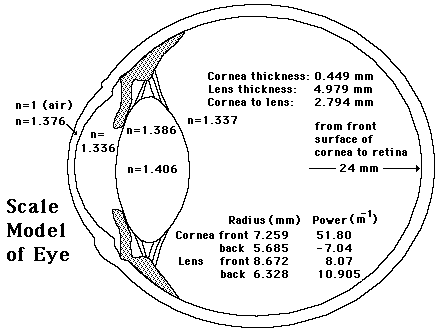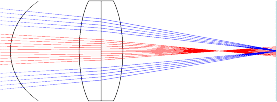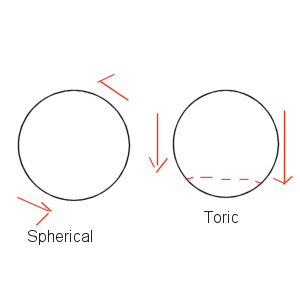Not everyone in the world are have 20/20 vision. Inheritance and aging are two key factors why there exists vision problems. We are here to explore the mathematical aspect of these common eye problems - mainly how light rays focus inside the eye how different types of lens help to correct the errors.

Let us assume the light rays to come from the left. First the rays reach the arch (the cornea), where it has a refraction index (n) of 1.376. Any index of refraction greater than 1 means it will refract inward, in another word, converge. Approximately The cornea represents the strongest part of the refracting power of the eye, providing about 80% of the power of the system. Immediately, the light goes pass the aqueous humor, where they will hit the crystalline lens, which has two different indexes. The top of the lens have n=1.386, while the center has n=1.406. For convenience, I use n=1.406 in all my drawings for the len's index of refraction. In the end, the light rays will converge/focus into one single spot on the retina.

In refractive errors that we will discussed below, myopia, hyperopia and astigmatism, the optical power of the eye is generally constant across the pupil and it can be corrected by glasses or contact lenses. If you absolutely hate wearing glasses/contacts, you can always get you eyes lasered.
This occurs when a distant object looks blurry and close things can been seen clearly. The reason behind it is that the eyeball is either too long or the refractive power of the eye's lens is too strong, therefore the image is focused in front of the retina rather than upon it.

One way to fix this problem is by wearing glasses that contain minus lens. (lens that are thinnest in the middle and thickest on the outer edges) The minus lens, which is concave on both sides, help move the focus back. As the light rays come in from the left, they get refracted and was spread away from the center. This gives light rays a broader band before they hit the cornea. The following diagram is a simple illustration.

It is interesting to note that the glasses we wear these days differ from the ones 60 years ago. Originally, glasses are made of.......glass, but with the technology nowadays, people seemingly want to wear something that 1) unbreakable 2)lighter 3)thinner lens. So new forms of lens like the high index plastic are more of the public's interest. These "new" lens provide a great index of refraction, therefore the thickness of the lens decreases and so is the weight. Since high index plastic are affordable, and I wear them, so I pick the median of its range (n=1.62) as my index of refraction of glasses in my diagrams.
| 1.50-1.51 | Starndard [CR-39] Plastic Lenses |
| 1.52 | Crown Glasses |
| 1.59 | Refractive Index Polycarbonate |
| 1.53-1.71 | High Index Plastic |
On the other hand, farsighted is the exact opposite to the nearsighted symptoms. It occurs when a nearby object is blurry and distant object is clear. Reason is that eyeball is either too short or the refractive power of the eye's lens is too weak, therefore the image is focused behind the retina rather than upon it.

One way to correct hyperopia is to wear glasses with plus lens. Our crystalline lens within the eye is plus lens itself, so by placing another plus lens ahead of our cornea help converge the light rays earlier and therefore bringing the focus back up front onto the retina, as shown below.

Another common vision problem is astigmatism. Astigmatism may occur along with myopia or hyperopia. Astigmatism usually occurs when the cornea has an irregular curvature. Normally the cornea is smooth and equally curved in all directions and light entering the cornea is focused equally on all planes, or in all directions. In astigmatism, the front surface of the cornea is curved more in one direction than in the other.

As you can see above, the center portion of the cornea (the first arch) sticks out more as compared to the sides. Light rays coming in toward the middle will have their focus in front of the retina. The sides of the cornea (top and bottom in this case) have a different smoothness than middle section, and light rays coming in on both sides focus on the retina. In this case, we have two foci and this causes headache and distortion of images at all distances.
The corrective lenses needed when astigmatism is present are called Toric lenses and have an additional power element called a cylinder. They have greater light-bending power in one axis than in others.

As shown above, spherical lenses have the same power all around the lens. Since it doesn't matter if the lens rotates on your eye or not, this is the type of lens one wears if he/she is near/farsighted. As for those with astigmatism, they need two different powers in the lens to focus. If the lens do rotate like spherical ones, then if the power will change and the focus is never be adjusted onto the retina all the time. This is why the toric lens are usually heavier at the bottom to keep the lens from rotating. This
Here are you USEFUL links that help me make this project possible!
![]() Howstuffworks - How corrective lens work
Howstuffworks - How corrective lens work
![]() Refractive errors and their correction
Refractive errors and their correction